More about Greece
This story was written by
Rick Archer
Starting in 2004, SSQQ has taken two cruises a year. One
cruise each year is our popular dance cruise around the Caribbean
while a second cruise is booked to a "Destination".
In 2004 we went to Mardi Gras in New Orleans. In 2005 we went
to Alaska. In 2006 we went to New England. In 2007
we went to Hawaii. In 2008 we try our most ambitious trip yet
- the SSQQ Cruise to Greece.
As I am sure most of you
remember from your Ancient History courses, as far as the Western
Civilization is concerned, Greece is where it all began.
The people of the region attempted to explain the
world through the laws of nature. They made
important discoveries in science. They developed
democracy, where people govern themselves rather
than being ruled by a king. The Greeks also valued
beauty and imagination. They wrote many stories and
plays that continue to be performed today. The
ancient Greeks developed a great
many traditions that we
take for granted without even
thinking about their origins (for example, the
Marathon and the Olympics).
This are the reasons why Greece is often known
as the Cradle of Western Civilization.
If it were not for the
Greeks, we would not have the Democracy we take for granted.
If it were not for the Greeks, we might be speaking Persian
today. If it were not for the Greeks, we would not
have the Trojan War, Greek Mythology, Greek Philosophy,
Greek Drama, or the Olympic Games.
Obviously Greece has had a profound effect on the course of
Western history.
|
 |
The Civilization of
ancient Greece flowered more than 2500 years ago.
Greece is an extremely mountainous country that makes it very
difficult for agriculture. Consequently the ancient Greeks
were forced to adapt. They became a sea-faring nation.
They also developed a passion for knowledge and culture. As a
result, Greece became the most advanced scientific country of its
time. Known for its advanced mathematics and astronomy, Greece
is the country that gave us Archimedes, Ptolemy and Pythagoras.
Known for its medicine, Greece gave us Hippocrates and Galen.
Perhaps what Greece is most famous for is its Philosophers.
The ancient Greeks seem to have been a most inquisitive group of
people. Socrates, Plato, and Aristotle were prodigious
scholars whose ideas were deeply influential. Socrates was a
rebel who taught people to question authority and to act on their
own principles even if it meant challenging the established way of
doing things. Socrates is given credit for the ideas that led
to the formation of Democracy. Unfortunately, Socrates
became so unpopular with the people who were in power that he was
executed mainly for teaching people to think for themselves.
No wonder we admire these people!
Before Democracy came along, the existing
systems of government in the Greek city states
included Monarchies, Tyrannies, and Dictators.
Athens itself used Oligarchy as their system
of government. Oligarchy means 'rule by the
wealthy few'. But the scholars of Athens could
see the selfish decisions of wealthy were ruining the morale of the
people and preventing progress. The scholars spoke up and made
persuasive arguments in favor of this new idea called
Democracy. First Aristotle wrote the Athenian Constitution.
Then Solon, the Father of Democracy, implemented the
new system.
Later it fell to a man named
Cleisthenes
to continue the development of Athenian Democracy. Cleisthenes
was the grandson and namesake of a foreign Greek tyrant, the ruler
of Sicyon in the Peloponnese. For a time he was also the
brother-in-law of the Athenian tyrant, Peisistratus, who seized
power three times before finally establishing a stable and
apparently benevolent dictatorship. It was against the increasingly
harsh rule of Peisistratus's eldest son that Cleisthenes championed
a radical political reform movement which in 508 ushered in the
Athenian democratic constitution.
It was under this political system that Athens successfully resisted
the Persian onslaughts of 490 and 480, most conspicuously at the
battles of Marathon and Salamis. These victories in turn
encouraged the poorest Athenians to demand a greater say in the
running of their city.
So it was
in the late 460s that Pericles presided over a
radicalization of power that shifted the balance
decisively to the poorest sections of society. It was
Pericles who made this new system of government
truly work.
From 460
until 429 BCE when
he died of sickness, Pericles controlled Athenian
affairs. During Pericles rule, Athens reached it's
greatest political, social, and economical power. He
established a building project, which included the
Parthenon, which today is still visible on
top of the Acropolis.
It was the democratic Athens of Pericles that won and lost an
empire, that built the Parthenon, that gave a stage
to Aeschylus, Plato, Sophocles, Euripides and
Aristophanes, and laid the foundations of
western rational and critical thought.
|
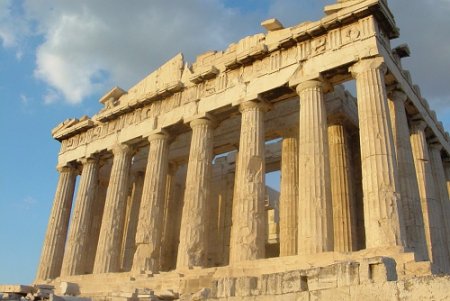 |
Despite these incredible contributions,
unfortunately Greece later fell on difficult times. For nearly
two thousand years, Greece was subjected to constant oppression by
outside empires. After its heyday with Alexander the Great,
Greece was conquered by the Romans who ruled Greece
for over a thousand years. Next came 400 years of oppression
by the Ottoman Empire and Turkey. It wasn't until 1829
that the Greek people successfully regained control of their own
land. The next hundred years weren't any easier.
Greece was constantly subjected to further meddling in its affairs
by European Countries and endured more problems with its longtime
enemy Turkey.
Greece again came under subjugation when the Nazis invaded during
World War II (who can forget the immortal film Guns of
Navarone?)
However, after World War II, with the help of the Marshall Plan, Greece
began a gradual return to strength and autonomy. Now that
Greece has had 50 years of peace and independence, this country has
begun to flourish. Today Greece enjoys one of the highest
standards of living in the world thanks in large part to tourism.
People are drawn from all over the world to see the spectacular
beauty of this rugged mountain country as well as the fascinating
islands that dot the Aegean Sea.
As our SSQQ community begins to gray a bit, many of us are developing a
desire to see the world and understand history better. I
cannot tell you how many people say this trip is something they have
wanted to do their entire life. It is no surprise that we are
drawn to Greece as well as to Italy, Crete, Sicily, and Turkey.
After all, this is where it all started.
I spoke to an SSQQ student who recently had visited Greece. I
asked her to sum up the most interesting thing about her trip.
She replied, "That's easy - I enjoyed seeing the Ruins!
As I walked around the Temple of Artemis in Ephesus (Turkey), my
tour guide taught me more ancient history in an afternoon than I
ever absorbed in high school and college combined. It was
absolutely fascinating!"
However, you don't have to be retired or near retirement to develop
a fascination for the Mediterranean. One day my daughter
Samantha asked me for money to buy some Christmas presents.
Sensing an opportunity, I ask Sam, a Junior at Duchesne Academy, to
pretend she was a travel agent and identify some of the places she would like
to see on our Greece-Italy-Turkey adventure. Her eyes lit up -
she had just finished studying Greece in her sophomore year.
Sam said she would be glad to help. So she pulled out her
notes from last year and started writing.
I was impressed with Sam's work. I think we might just have a
future Travel Writer in the family.
Ten Places I Would Like to
See in the Eastern Mediterranean
Samantha Archer
November 2007
10. Catacombs of Rome
While the Roman
Catacombs are just on the outskirts of the heart of the
city, you won’t want to miss something this rich in history
(not to mention spookiness). The ancient peoples of Rome,
the Etruscans, built the original catacombs. The Christians,
who sought affordable ways to bury their dead with the body
still intact, then adopted the practice of burying dead in
the catacombs. The forty Roman catacombs, situated along via
Appia, via Ostiense, via Labicana, via Tiburtina, and via
Nomentana, are currently under the care of the Roman
Catholic Church. The Catacombs of San Callisto house the
crypt of the Popes, St. Cecilia, and the Sacraments. Maybe
catacombs sound too creepy for your taste – but who knows
what fascinating artwork and artifacts can be found down
there.
9.
Corinth
Today, Corinth is
the second-largest city on the Peloponnesian Peninsula. In
ancient times, it rivaled the likes of Athens and Sparta
until its destruction by the Romans in 146 BC. The city was
then rebuilt by Julius Caesar in 44 BC. Famous figures who
have walked its grounds include Alexander the Great and the
Apostle Paul, who wrote a famous epistle to the Corinthians.
Sights to see in this ancient city include the Temple of
Aphrodite, the Temple of Apollo, the Temple of Octavia
(sister of Roman Emperor Augustus) and the Bema, the
platform St. Paul pleaded his case in front of the Roman
governor Gallio. Corinth is the perfect opportunity to get
away from the bustle of Athens and still explore beautiful
Grecian ruins.
8.
Taormina
Taormina – a small
city on the outskirts of Messina – holds a great amount of
cultural history because it has acted as a crossroads
between the many peoples who have called its lands home. The
city itself has much to offer – the fountain in the piazza
duomo, the monastery of the San Domenico, the Taormina
Cathedral. The Cathedral houses the Byzantine Madonna, also
called the non hand-made Madonna. Legend has it that this
painting was left hidden inside a wall by angels – hence the
name “non hand-made,” for it was made by the angels, not
humans. An absolute must-see monument is the Palazzo Duca S.
Stefano – the palace of the Duke San Stefano. Its
thirteenth-century Gothic architecture also has a nearby
garden of equal beauty. So take a stroll through the town
and enjoy its architectural achievements – you won’t be able
to miss the nearby Mount Etna, which serves as a backdrop to
the town.
7.
National Archaeological Museum
The National
Archaeological Museum at Athens is considered one of the
great museums of the world. It is home to some of the
richest historical artifacts from one of the richest
civilizations the world has ever known. The most interesting
artifact by far is the mask of Agamemnon, found by Heinrich
Schliemann in 1876 during an excavation of the ancient city
of Mycenae. “I have gazed upon the face of Agamemnon,”
Schliemann claimed. Attacks at the mask’s authenticity have
been made – but that doesn’t make this artifact any less
interesting. Agamemnon, who appears in Homer’s Illiad
and a story of his own name by Aeschylus, is one of the more
well-known characters in the vast arena of Greek literature.
Other interesting artifacts with literature ties include
Nestor’s Cup and Theseus’ Ring. Sculptures of Greek heroes
and Gods are also found in the Museum – Marathon Boy and
Poseidon of Cape Artemision among them. These
archaeological treasures are plentiful in the museum, so use
your time to observe some of the remaining artifacts of the
ancient world.
6. Great
Theater
The Great Theater at
Ephesus is thought to be the largest outdoor theatre from
the ancient world. While it was originally built for 25,000
people, expansions made by Roman emperors made it large
enough to hold an estimated 44,000 people. Built into Mount
Pion in Ephesus, the theatre is one hundred feet high and
those who feel like making the trip to the top will behold a
beautiful spectacle of all the ancient ruins Ephesus has to
offer. Historically, additions were made by the Roman
emperors Nero, Claudius, and Trajan, and St. Paul delivered
a sermon on pagan worship in the theatre. Use your time to
see the historically important Ephesian ruins, but
definitely make a trip to enjoy the beauty of the area on
top of the theatre’s steps.
5.
Colosseum
Think Rome for a
second – what immediately pops into your head?
The Colosseum is one of the
most well-known European structures, ranked with the Eiffel
Tower of Paris and Big Ben of London. The Colosseum was
completed in an estimated ten years, from 70 to 80 AD under
the Emperor Vespasian. Spectacles of all kinds were held in
the Colosseum – enacted were recreations of battles, sea
battles, and dramas. The mechanization for these enactments
were of mind-blowing proportions – especially those used to
fill the amphitheater with water (they exist to this day).
The mind-blowing size of the Colosseum, its cultural and
historical importance, and its beautiful architecture make
it a definite visit while in Rome.
4. St.
Peter’s Basilica
While a visit to the
Vatican tops the list for most Rome-goers, many are
attracted to St. Peter’s Basilica. From the striking beauty
of the structure’s architecture to the artwork and
sculptures housed there, the Basilica has some of the most
gorgeous treats for the eye in Rome. Emperor Constantine
began its construction in 342 AD, near the downfall of the
Roman Empire in 476 AD. Pope Nicholas V restarted
construction near a thousand years later, and today it
stands as an amazing spectacle to behold. Besides the tomb
of St. Peter, the bodies of Catholic British royalty Edward
Stuart, Charles Stuart, and Henry Stuart are also entombed
in the Basilica. As a side trip, take some time to see the
Sistine Chapel – a complete spectacle on its own.
3.
Acropolis
The Acropolis, known
as the “sacred rock” of Athens, hold the most recognizable
buildings in Grecian history. In ancient times, Athens was
known as a city of art and architecture – a great deal of
this is exhibited in buildings such as the Parthenon and the
Temple of Nike. A great deal of the buildings on the
Acropolis were built during the Golden Age of Athens (fifth
century BC) under Pericles. The geometrical and
architectural accomplishments are exhibited throughout the
area. The Parthenon itself is also a representation of
Athenian democracy. Be careful while exploring this Grecian
treasure – it is illegal to steal even a rock from the
site’s ruins.
2. Mount
Etna
Mount Etna is
definitely a sight to behold – as the largest active volcano
in Europe, its dangerous beauty entices all who get to
experience the volcano. While in Messina it is typically
easy to see (weather permitting), getting a hands-on
experience is something any adventurous soul would want to
do. The volcano is 10,910 feet high (Mount St. Helen’s is
currently 8,365 feet). The most famous eruption of the
volcano is the 1669 eruption – it was also the most
destructive. While Messina itself was not as affected as
nearby towns, the region suffered from the lava flow. Take
this opportunity to scale a European treasure – but watch
out for the red stuff.
1.
Palace of Knossos
Whether or not the
rest of this list sounds appealing to you, this site is the
one you do not want to pass up. The history of the Palace of
Knossos is interesting beyond a doubt – the historical and
mythological ties transcend any Mediterranean site out
there. Excavated by Sir Arthur Evans in the early twentieth
century, the Palace of Knossos was thought to be a centre of
Minoan civilization. The advanced technology of the Palace –
including plumbing – was an interesting find for
turn-of-the-century archaeologists. The discovery of the
artwork, the frescoes in particular, were also engaging. The
Palace is also thought to be the origin of the legend of the
Labyrinth and the Minotaur, the Greek half-man half-bull.
Legend has it that Daedalus, father of disobedient Icarus,
was captivated by King Minos and forced to design the
Labyrinth. The Minotaur was not defeated until the Athenian
Theseus killed it using his clever wit. However, these facts
barely touch the interesting side of the Palace. Almost
forty years ago, in 1970, a geologist by the name of H.G.
Wunderlich happened upon the Palace – and made some
particularly interesting hypotheses about the Palace. In his
book, The Secret of Crete, he goes as far to suggest
that the Palace itself was not a Palace of civilization – it
was, in fact, a death Palace, built by the
death-obsessed Minoans for their deceased. The fact that the
island of Crete lies in between the European and the African
sides of the Mediterranean made it a center for ancient
ideas to pass through to the more modern European side. The
Egyptians, famous for their treatment of the dead, plausibly
transferred beliefs to the Minoans, who began to worship
their dead as the Egyptians did. Evidence is found all over
the Palace in support of Wunderlich’s theory – from the
bull-jumping frescoes to the eerie throne room to the bones
found buried near the Palace. The Palace is most certainly
worth taking a look at for yourself – perhaps you might
agree with his out-of-the-box suggestions.
|
|
Rick Archer's Note: The
Information below is Marla Archer's original promotional page.
It contains a great deal of valuable information about the
locations we visited in 2008
|
|
Rome |
Our cruise departs
on Sunday from
Civitavecchia, Italy at
5:00 pm
in the evening. Why not come a day or two early
to explore Rome, Italy’s
most populous and famous city
in even greater depth.
Civitavecchia is the gateway to all the magnificence of the
ancient city of Rome.
Whether it's the Forum, the Sistine Chapel, the Pantheon or
St. Peter's Basilica that sparks your interest and
intellect, Rome is home to a lifetime's worth of historical,
architectural and spiritual sites. Depending on traffic, the
drive from Civitavecchia to Rome takes approximately an hour
and a half.
Experience the history of Rome as you wander around the
Colosseum, one of the most important monuments of ancient
Rome and the Roman forum. A masterpiece of classical
architecture, the Colosseum is an enormous amphitheater
where gladiators, Christians and wild beasts once battled to
the death in front of 55,000 spectators. Upon completion,
spectacular 100-day celebrations were organized as part of
the opening ceremony in 72 AD. Its name is believed to come
from Nero's enormous statue of Colossus that stood close by.
The admission charges are about EUR10.
The Forum was
designed to be the centre of social, political and economic
life in the city. The innumerable remains include the
well-conserved triumphal arch of Emperor Septimius Severus,
with reliefs depicting his victories and the base of the
Temple of Saturn with its eight columns and their splendid
Ionic capitals. The 'Rostrum' is the famous platform from
which Mark Antony gave his oration in Shakespeare's play
after Julius Caesar's assassination. The platform became the
setting for many important events in Rome's history. It was
named the 'rostrum' after the bows of the ships that form
the decorative motif. The Temple of Vesta was the home of
the Vestal Virgins, charged with
keeping the sacred flame alight. The circular foundations
still remain, near to a garden in which traces of the House
of the Vestal Virgins can still be seen. The Basilica of
Constantine and Massentius was used as the court, and the
three remaining barrel-vaulted naves give an idea of its
gigantic structure. The Arch of Titus celebrates victories
in Judea, and in the reliefs you can see the spoils of war,
including an altar and a seven-armed chandelier. Admission
is free; guide tours in English cost EUR3.20
Visit the Vatican Museum, where you can walk through the
many rooms that house the largest art collection in the
world. The Vatican
is among the most important historical sites in the world.
The seat of the Holy Roman Catholic Church, The Vatican is
also the home of the Pope. As the smallest state in the
world, the Vatican has figured in key events throughout
history. Occupying about one half kilometer of Rome, The
Vatican is further significant because of its fabulous
architecture, religious, and artistic treasures. It was Pope
Julius II della Rovere in the 16th century who commissioned
Michelangelo to paint the history of creation on the ceiling
of the Sistine Chapel. Among countless other notable events
in the history of this important city are the convening of
the College of Cardinals, at the death of a reigning
Pontiff, for the purposes of electing a new Pope. No visit
to Rome is complete without an excursion to The Vatican, a
place so steeped in history and tradition that you will
never forget it.
Travel
through the magnificent St. Peter’s Basilica, the largest
church in the world. . Construction began in 1452 on the
site where St. Peter was buried and took over 100 years to
build. It rests on 800 pillars and is littered with 44
altars. During the next
200 years, such famous masters as Bramante, Michelangelo,
Raphael and Bernini worked on its design and created an
unparalleled masterpiece. View Michelangelo's "Pieta" and
the 85-foot-high Bernini Pulpit. Admire one of the many
masterpieces created by Michelangelo, the famous statue of
Moses. This majestic bearded figure is depicted holding the
tablets of the Ten Commandments.
If this is your first visit
to Rome time, you must take in the Sistine Chapel. It is
considered a masterpiece of Renaissance art. Dominating
the chapel is Michelangelo’s ceiling paining of the
“Creation of the World.”. The Sistine Chapel receives 50
million monthly visitors. The Chapel was built somewhere
between 1477 and 1481 by Pope Sixtus IV. From 1480 to 1483,
famous artists of Renaissance, such as Botticelli, Perugino,
and Ghirlandaio, decorated the walls. After twenty years,
Julius II commissioned Michelangelo to decorate the ceiling
in 1508. Today, after the restoration, tourists can visit
the chapel and see Michelangelo's “Last Judgment.” You will
invariably find the Sistine Chapel crowded with hundreds of
tourists, so be prepared. The best way to see it is to go to
the Vatican Museums early, so that you're among the first in
line when they open. Silence should be observed and
photography is not prohibited.
The Pantheon was commissioned by Marcus Agrippa, restored by
Domitian, and subsequently rebuilt by Hadrian (who added the
dome) before being turned into a church in the early 7th
century by Pope Boniface IV. The building's sole source of
light is the opening at the dome's apex (the oculus);
according to popular legend, this formed the base for the
bronze pinecone that is now in the Vatican's 'Pigna'
courtyard, where it is used as a fountain. Many famous
Italians are buried in the Pantheon, including Renaissance
painter Raphael and King Vittorio Emanuele I.
No visit to Rome can be complete without a stop at the
Fontana di Trevi.
Tradition has it that throwing a coin over your left
shoulder into the fountain guarantees a swift return to the
world's most beautiful city. Anita Ekberg's dip in it was
immortalized in Fellini's 'La Dolce Vita', and Italian actor
Toto even sold it to an American, passing himself off as its
owner. Earlier it was the setting for the award-winning
"Three Coins in the Fountain" motion picture, ensuring its
popularity worldwide. Designed by Nicola Salvi for Pope
Clemente XII, it was completed in the second half of the
1700s. The statues in the centre represent Neptune supported
by Tritons on either side while rococo-style Poli Palace
provides the perfect backdrop.
If time permits, take a visit to Trastevere on Sunday
morning. This area
of Rome was originally built to be a city port where
storehouses held goods at the time of Augustus and continued
to do so until the end of the 19th century. Trastevere then
became a downtown market residential quarter and has now
developed into a very desirable quarter. The heart of the
district is Piazza di Santa Maria in Trastevere with its
lovely church, a 17th century palazzo and a fountain in the
middle which is probably Rome's oldest, having been designed
by architects such as Bernini, Fontana and Della Porta.
There are still some well-conserved medieval houses On
Sunday mornings, you can visit the 7th Corte dei Vigili
in Via dei Salumi, and if you enter the guards' rooms, you
will see grafitti on the walls written by Roman soldiers who
served the emperors from Septimus Severus to Caracalla, in
addition to notations of their guard duty.
If you have the extra time, explore the flavors and history
of Etruscan Italy. Pre-dating the Roman Empire, the Tuscia
region has been the cradle of the Etruscan civilization and
is evident in hilltop Tuscania, with its roots dating from
the 9th century B.C., contrasting with the Renaissance
gardens, fountains, pavilions and maze of Villa Lante.
Leaving the port area and heading north from Civitavecchia,
you will view the warm colors of the Etruscan countryside.
Make your way to Bagnaia. Stop by and appreciate a visit to
the Renaissance gardens of Villa Lante. To create these
beautiful gardens, one of the greatest architects of the
time, Vignola, was called upon. Fountains, pavilions and a
box-tree maze were all combined to create a peaceful yet
playful atmosphere. Walk through these inspirational and
often whimsical gardens, taking time to enjoy the serenity
and beauty of the setting. Then proceed to the lake of
Bolsena and stop for views of the lake and the islands
Bisentina and Martana Standing at the top of a rocky hill
overlooking the Maremma region, Tuscania’s Etruscan and
Renaissance buildings have been beautifully restored and
still reflect the Etruscan history. Walk through the narrow
cobblestones lanes of this charming village and take in the
views of the surrounding valleys.
The Euro, the currency of the European Union is the official
currency in Italy. Many stores and restaurants accept major credit cards, which
usually offer a good exchange rate. When shopping remember
there is a value-added tax to most purchases.
Depending upon the size of our group, we will have our SSQQ
Welcome Aboard Cocktail party this evening. Meet your fellow
SSQQ Cruise passengers and enjoy unlimited cocktails and
dance to your favorite tunes as we sail along
Italy's coastline.
|
|
Sicily |
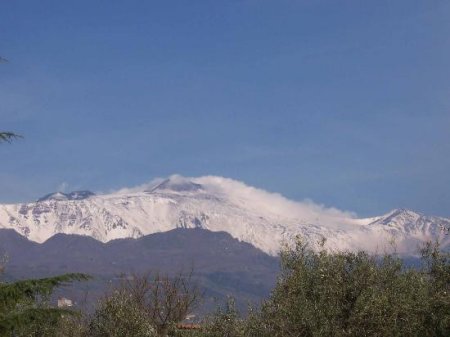
Mount Etna, Sicily |
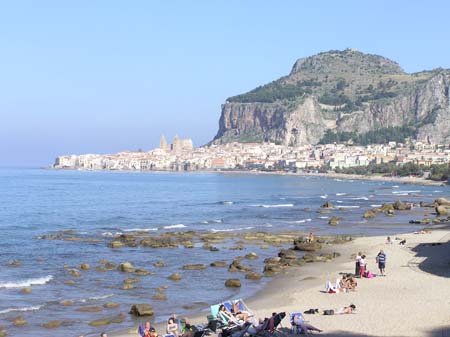
Beach in Sicily |
We
arrive at the port town of Messina on the
island of Sicily at 10:00 am
on Monday.
Sicily
is an amazing island with a rich architectural and
historical heritage, not to mention compelling natural
beauty. It can be overwhelming in many different ways,
especially for a first time visitor. The following is a
list of highlights -- by no means all-encompassing -- but at
least one that will serve as a guide.
Messina is
just three miles off the coast of southern Italy’s mainland.
This bustling town has a
complex history with roots in Greek mythology but because of
an earthquake in the early 1900s, it's a relatively young
city architecturally. Since the majority of the city has
been rebuilt or refurbished within the last 100 years,
you'll find the town has an interesting blend of new
architecture and old styles.
For a show unlike any you've seen before, check out the
world's largest astronomical clock, Orologio Astronomico, in
the Piazza del Duomo. It's set in a 197-foot bell tower and
when the clock strikes noon, it comes to life. As Ave Maria
begins playing from a loudspeaker, the bronze mechanical
figures start to move. A lion roars, a bird flaps its wings,
and two historical heroines take turns ringing the bell, all
before it ends with a statue of Jesus appearing from a tomb.
Other things to do in Messina include taking a walk through
the Duomo, the town’s main cathedral in the Piazza del Duomo.
Although most of it has been refurbished in recent years, it
has retained some of the original Norman-style features from
1160, when the Holy Roman Emperor Henry VI built it.
Stop and make a wish in the Fontana di Orione in the center
of the piazza. The pre-baroque-style fountain was built to
commemorate Messina’s aqueduct and symbolized the four
rivers, Tiber, Nile, Ebore and Camaro.
Spend some time in the Museo Regionale. Here you’ll find an
amazing collection of art rescued from the1908 earthquake,
including pieces dating back to the 13th century.
If
you are more adventurous, a trip to Mount Etna is a
highlight for any visitor to this area. Enjoy a scenic ride
to Europe's largest active volcano. While en route, enjoy
the delightful countryside of vineyards and orchards. The
winding road up the slope passes through vast lava fields to
the Silvestri Spent Craters, almost 6,000 feet above sea
level. There you will be able to walk along the brim of
these craters. You can see remnants of past eruptions.
The road cuts among streams of solidified lava -- a black,
petrified river flowing from the top of the mountain. More
than 130 eruptions have been recorded since the 4th century
BC; the most recent one occurred in 2002. The descent offers
awe-inspiring views of volcanic cones and streams of
hardened lava. Although the best views of the actual peak of
Mt. Etna are from the distance of many miles, a closer
inspection of its powerful destruction cannot help but
impress any visitor.
Take a tour to the
well-known resort community of Taormina renowned for
its beautiful setting. It is perched on a mountainside on
the West Coast of Sicily.
Stop below the village of Taormina before proceeding
uphill to the village gates. Upon reaching Taormina, you'll
walk past the ancient village's many squares and see the
small boutiques located along the Corso Umberto. Here you
will find the "essence of Sicily," Taormina. Built in the
3rd century BC, the city was later almost completely
renovated by the Romans. Taormina is perched on a terrace
overlooking the sea. It’s medieval character will delight
you. Near the center of Taormina, you will find cobblestone
streets to Palazzo CORVAIA, a 15th century building adorned
with classic double windows. Proceed to the impressive Greek
Theater, built in the 3rd century BC. Renowned for its width
and for its unique acoustic qualities, it is still used for
open-air concerts. Weather permitting; you will have an
impressive view of Mt. Etna.
Enjoy the
busy main street with its numerous shops and cafes and to
savor the charm and atmosphere of this small medieval town
with its palaces, squares, staircases and small side alleys.
A
visit to the town of Palermo would be another
choice. Palermo is home to the island’s best museums. It
is one of several, well kept medieval towns that should be
explored.
The streets of Palermo can seem dirty, polluted, and just plain
annoying, particularly for those who enjoy exploring the
city by foot; Palermo is pedestrian-unfriendly in the
sense of having some extremely narrow sidewalks and
walkways, and fast drivers who like to drive awfully close
to pedestrians, but don’t let that deter you from exploring
Palermo’s richness, including: the Palatine Chapel and the
Monreale Duomo.
Palermo's history is marked by the multitude of conquerors
and subsequent cultures that settled there. The Phoenicians,
Carthaginians, Byzantines, Arabs, Normans, Romans, French
Angevins, Spanish Aragonese, and even the Mafia are among
those who have contributed to Palermo's collective cultural
history. The resulting cultural blend emanates from
Palermo's buildings, art, and people. From the Cappella
Palatina with its stunning biblical mosaics and Arab-style
stalactites and alveoli ceiling to the Quattro Canti, a city
square in the heart of Palermo containing four
seventeenth-century palaces, Palermo has played host to
those seeking adventure for centuries.
|
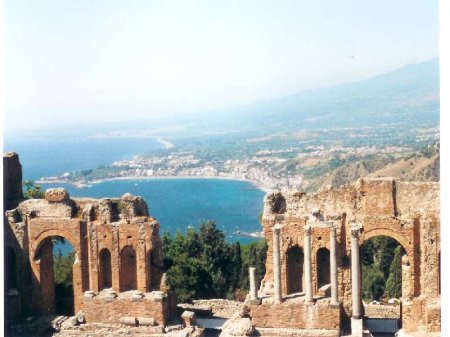
Taormina Overlook
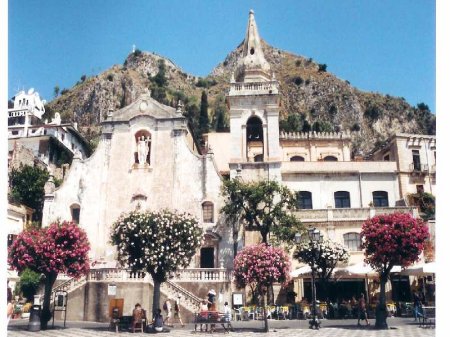
Taormina
Town Square
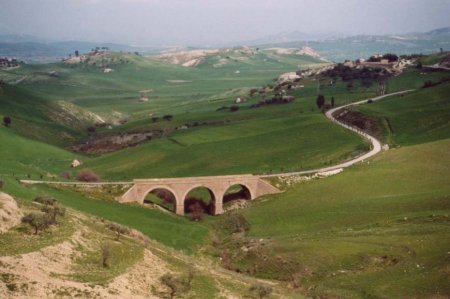
Sicilian countryside
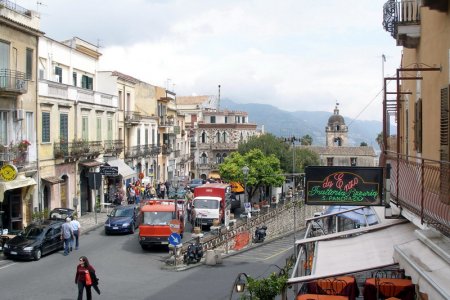
Taormina
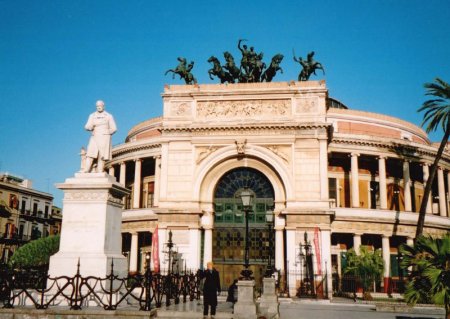
Palermo
Theater |
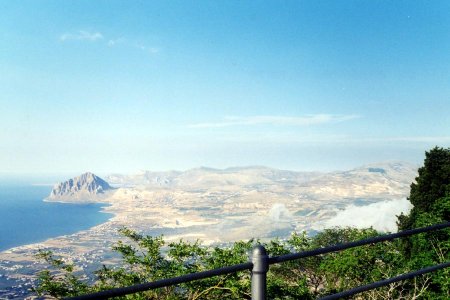
Sicilian Coastline |
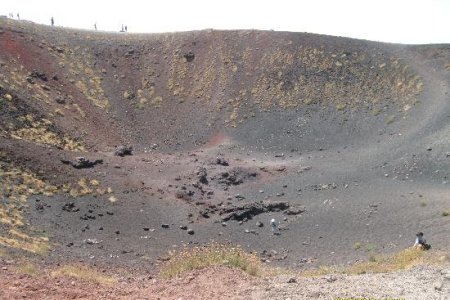
Silvestri Crater |
|
|
Athens |
|
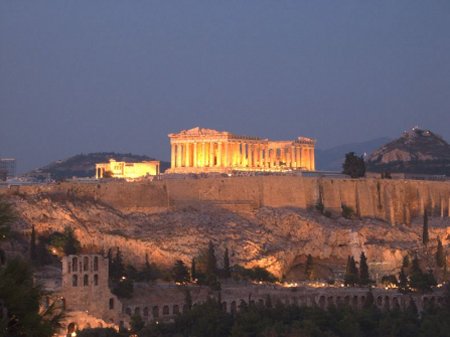
Acropolis at night |
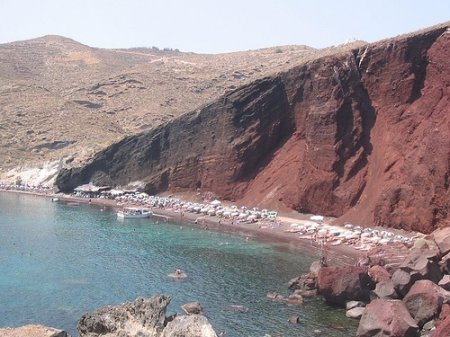
Red Beach |
|
|
|
We arrive in Athens on
Wednesday at 7:00 am. The
ship doesn’t depart until 7:00 pm,
so you have a full day to explore this magnificent city.
Athens is
situated in the prefecture of Attica and extends to the
peninsula that reaches up to Central Greece. Mountains to
the north and east, and the Sardonic Gulf to the south and
west surround Athens. The sun shines over Athens all year
round. The climate is one of the best in Europe. It is
located just a few miles from the port of Piraeus, the
central commercial port of the capital, and the shores of
southern Attica. Piraeus is the main port of Athens, the
biggest in Greece, and one of the most important in the
Mediterranean Sea. Piraeus is walking distance from Kastella,
a hill strewn with beautiful houses that offers a majestic
view of the Saronic Gulf.
Athens has constantly been inhabited since Neolithic Age.
The 5th century was the time of its ultimate bloom, when
moral values and civilization surpassed city limits and
became the motherland of western civilization. In the
centuries that followed, many conquerors tried to take over
Athens. In 1834 Athens was chosen to be the capital of the
newly established Greek State. The city that now hosts more
than 4,5 million people was constructed around the Acropolis
walls. Today it is the political, social, cultural,
financial and commercial center of Greece.
Athens is a city of different aspects. Take a walk around
the famous historic triangle (Plaka, Thission, Psyri). This
old neighborhood reveals the coexistence of different eras.
You will find old mansions, some are well preserved and
others are worn down by time. There are also luxurious
department stores, small intimate shops, fancy restaurants
and traditional taverns. Traditional handicrafts, though
sometimes expensive, are the most authentically Greek
souvenirs. In Athens, Monastiraki and Plaka are the best
places to purchase handcrafted goods. Experience the
traditional flea market.
You'll find ceramics, brightly colored embroidery and wall
hangings, flokati rugs and tapestries.
The heart of Athens beats in Syntagma Square. This is where
Parliament and most of the Ministries are. A few miles from
the historic center, you can enjoy the sea breeze. Or you
can head up north and enjoy the fresh air at the more classy
neighborhoods of Marousi, Melissia, Vrilissia and of course
Kifisia.
Athens and Attica in general have the most important
archaeological monuments (Acropolis, Odeion of Herodes
Atticus, Olymbion, Roman Market, Panathinaiko Stadium and
The Temple of Poseidon.) The capital has many imposing
neoclassic buildings, The Greek Parliament
and Athens
Academy and University. Don't miss visiting the museums
hosting unique treasures of Greece’s cultural inheritance.
Take a visit to
The National
Archaeological museum . It
ranks among the top ten museums in the world.
By far
the most important museum in Greece, this collection
contains artistic highlights from every period of ancient
Greek civilization, from Neolithic to Roman times. It houses
some of the most important artifacts from a variety of
archaeological locations around Greece. The
exhibitions can be traced to the development of the Art of
Greece from the prehistoric days to the golden age of Greek
thought, and all the way to the Roman times.
Holdings are grouped in five major collections: prehistoric
artifacts (7th millennium BC to 1050 BC), sculptures,
bronzes, vases and minor arts, and Egyptian artifacts. The
museum's most celebrated display is the Mycenaean
Antiquities. Here are the stunning gold treasures
from Heinrich Schliemann's 1876 excavations of Mycenae's
royal tombs: the funeral mask of a bearded king, once
thought to be the image of Agamemnon but now believed to be
much older, from about the 15th century BC; a splendid
silver bull's-head libation cup; and the 15th-century BC
Vaphio Goblets, masterworks in embossed gold. Mycenaeans
were famed for their carving in miniature.
Other stars of the museum include the works of Geometric and
Archaic art (10th-6th centuries BC), and kouroi and funerary
stelae (8th-5th centuries BC), among them the stelae of the
warrior Aristion signed by Aristokles, and the unusual
Running Hoplite (a hoplite was a Greek infantry
soldier). The collection of Classical art (5th-3rd centuries
BC) contains some of the most renowned surviving ancient
statues: the bareback Jockey of Artemision, a
2nd-century BC Hellenistic bronze salvaged from the sea;
from the same excavation, the bronze Artemision Poseidon
(some say Zeus), poised and ready to fling a trident (or
thunderbolt?); and the Varvakios Athena, a half-size
marble version of the gigantic gold-and-ivory cult statue
that Pheidias erected in the Parthenon.
No visit to
Athens would be complete without a visit to the Acropolis.
There you'll find the Parthenon, the largest building in the
Acropolis and one of the world's most awe-inspiring sights.
It was built as a temple to Athena and is still a remarkable
structure today.
The Acropolis has been nominated to be one of the 7 wonders
of modern world. In fact this trademark of Athens is one of
the favorites. The Holy Rock of Acropolis dates back to the
5th BC, the famous Golden Age of Periklis. Acropolis in
Greek literally means “the highest point of the town”.
The Acropolis hill (acro - edge, polis - city), so called
the "Sacred Rock" of Athens, is the most important site of
the city and constitutes one of the most recognizable
monuments of the world. It is the most significant reference
point of ancient Greek culture, as well as the symbol of the
city of Athens itself as it represents the apogee of
artistic development in the 5th century BC.
The Acropolis rock is part of a Late Cretaceous limestone
ridge that cuts through the Attica plateau in the northeast
to the southwest axis and includes the Likavitos hill, the
Philopappos (Museum) hill, the hill of the Nymphs, and the
Pnyx. The rock rises from the basin about 70 meters and
levels to a flat top 300 meters long by 150 meters wide. Its
flat top is due to the numerous landfills that have
accommodated construction of fortifications and temples
since the Mycenaean era. With its many shallow caves, the
abundant percolating water springs and steep slopes, the
Acropolis was a prime location for habitation and worship
location for Neolithic man. The Propylaea are the
monumental entrances to the sacred area dedicated to Athena,
the patron goddess of the city. Built by the architect
Mnesicles with Pentelic marble, their design was
avant-garde. To the south-west of the Propylaea, on a
rampart protecting the main entrance to the Acropolis, is
the Ionian temple of Apteros Nike, which is now being
restored.
The first habitation remains on the Acropolis date from the
Neolithic period. Over the centuries, the rocky hill was
continuously used either as a cult place or as a residential
area or both. The inscriptions on the numerous and precious
offerings to the sanctuary of Athena (marble korai, bronze
and clay statuettes and vases) indicate that the cult of the
city's patron goddess was established as early as the
Archaic period (650-480 B.C.).
The Parthenon
is the most famous surviving building of Ancient Greece and
one of the most famous buildings in the world. The Parthenon
has stood atop the Acropolis of Athens for nearly
2,500
years and
was built to give thanks to Athena, the city's patron
goddess, for the salvation of Athens and Greece in the
Persian Wars. The building was officially called the
Temple
of Athena
the
Virgin;
"Parthenon" comes from the Greek word
parthenos,
"virgin."
Throughout its long life, the Parthenon has functioned most
importantly as a Greek temple, but has also been a treasury,
a fortress, a church, and a mosque. Today, it is one of the
most recognizable icons and popular tourist attractions in
the world.
Athens has
always attracted peoples' attention, most notably for being
the birthplace of the Olympic Games.
It was the Panathenaic Stadium, which hosted the 1st
Olympic Games of the modern era, in 1896. However, its
history goes way before the 19th century AD. The site
of the Panathenaic Stadium was originally a small natural
valley, between the two hills of Agra and Ardettos, over
Ilissos river. It was transformed into a stadium by
Lykourgos in 330-329 BC for the athletic competitions of "Panathinea",
the greatest festivities in ancient Athens.
Between 140 and 144 AD, Herodes Atticus restored the
Stadium, giving it the form that was found at the 1870
excavation: the horseshoe construction with a track 204.07
meters long and 33.35 meters wide. It is believed that the
Stadium had a seating capacity of 50,000 people.
The modern times restoration of the Stadium was conducted at
the end of the 19th century, for the first Olympic Games
that were reborn in 1896. The Stadium was rebuilt with
marble from Mt Penteli, the same kind that was used 2,400
years before, for the construction of the Parthenon on the
Acropolis. It could now hold over 60,000 spectators. The
total cost was 1 million GrD, a huge amount of money in those days.
A visit to the Stadium is an absolute "must" when in Athens.
It is located in the centre of the city, on Vassileos
Konstantinou Avenue, on the east side of the National
Gardens.
Would
you like to read more about our Trip to Greece?
This article was researched by Rick Archer.
It appeared in the December 2007 SSQQ
Newsletter.
THE 2008 SSQQ TRIP TO GREECE
|
|
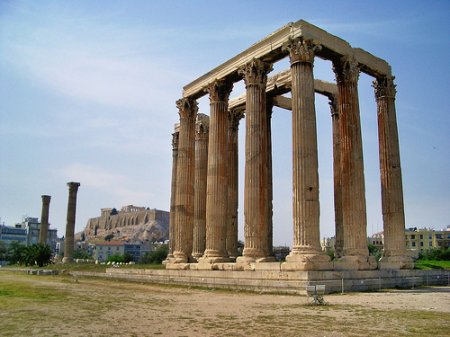
Temple of Zeus
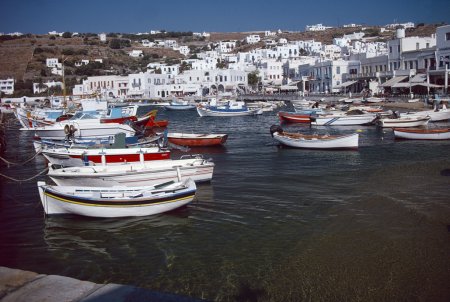
Greek
fishing village
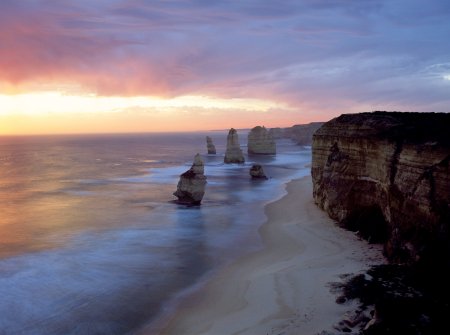
Greek
coastline
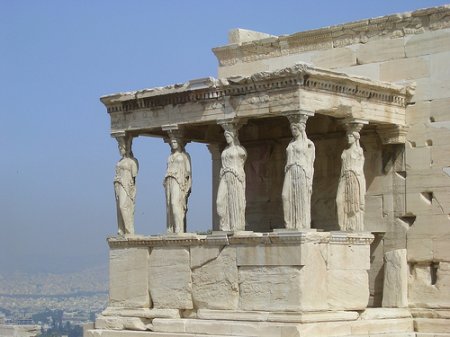
Acropolis close-up

Parthenon
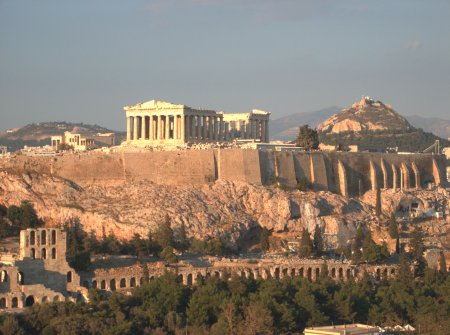
Acropolis in the daytime
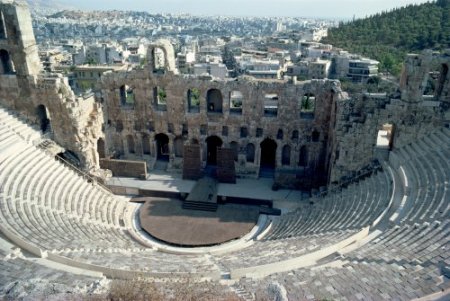
Temple
of Dionysus

Panathenaic Stadium, home of the first modern Olympics
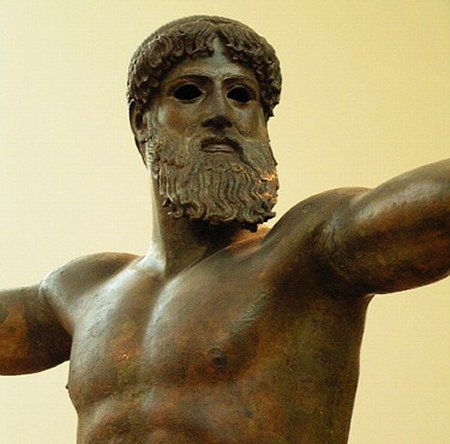
Poseidon |
|
 |
|
Ephesus,
Turkey |
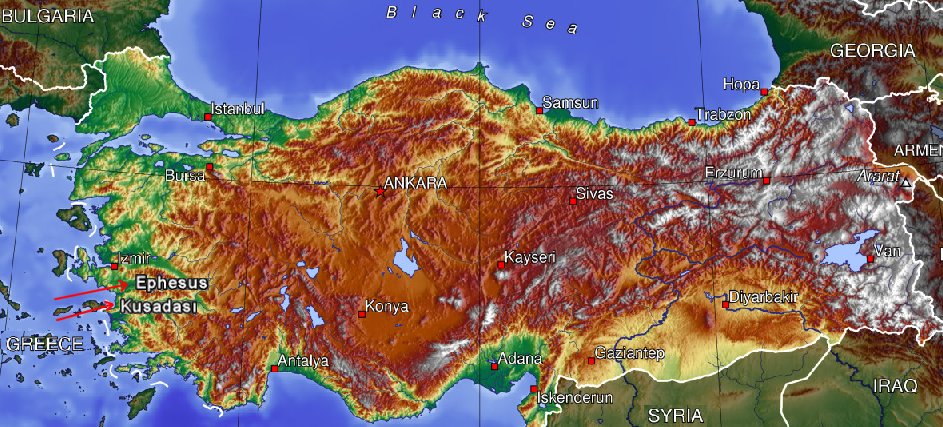
Kusadasi Port, gateway to
Ephesus |
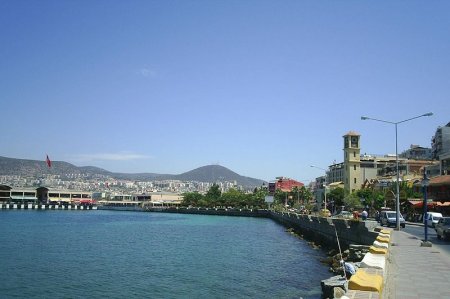
another look at Kusadasi
Port |
|
|
|
We arrive
at Kusadasi at
7:00 AM
on Thursday for
a full day of exploration.
Kusadasi is the gateway to Ephesus, a city created
by the Ionians in the 11th century B.C. and later
expanded by the Romans. Now considered to be one of
the grandest reconstructed sites in the ancient
world, the region also hosted the likes of
Cleopatra, Mark Antony, the Virgin Mary and John the
Apostle. Kusadasi has grown from a small sleepy
fishing village into a sprawling tourist center,
serving the thousands of tourists who flock to the
area to visit the nearby ruins of Ephesus. These
ancient ruins are considered the most important in
Turkey.
The site
of the ruins is large. Only an estimated 15% has
been excavated. The ruins that are visible give some
idea of the city's original splendour, and the names
associated with the ruins are evocative of its
former life. The theater dominates the view down
Harbour Street which leads to the long silted-up
harbor.
Don't miss
the chance to visit the once powerful trading and
religious city of Ephesus. Travel through the
Magnesia Gate, the main entrance to the ancient
city, and continue along marble streets grooved by
chariot wheels. Gaze upon beautiful temples,
porticoes, fountains and frescoes. Discover the
three-story Library of Celsus, the Temple of
Hadrian, the Odeum, the Fountain of Trajan and the
Great Theater.
The Great Theatre was considered the
most magnificent structure in the ancient city of
Ephesus. It is located on the slope of Panayir
Hill, opposite the Harbor Street, and easily seen
when entering from the south entrance to Ephesus. It
was first constructed in the Hellenistic Period, in
the third century BC during the reign of Lysimachos,
but then during the Roman Period, it was enlarged
and formed its current style that is seen today.
Being the largest in Anatolia, the theatre has the
capacity of 25,000 seats. The cavea has sixty-six
rows of seats, divided by two diazoma (walkway
between seats) into three horizontal sections. There
are three sections of seats. In the lower section,
Marble pieces, used for restoration, and the
Emperor's Box were found. The seats with backs, made
of marble, were reserved for important people. The
audience entered from the upper cavea. The stage
building is three-storied and 18 meters high. The
facade facing the audience was ornamented with
relieves, columns with niches, windows and statues.
There are five doors opening to the orchestra area,
the middle one of which is wider than the rest. This
enhanced the appearance of the stage, giving it a
bigger, monumental look. The theatre was used not
only for concerts and plays, but also for religious,
political and philosophical discussions and for
gladiator and animal fights.
The Library of Celsus was built in 135 AD to store
12,000 scrolls and to serve as a monumental tomb for
Celsus. It was unusual to be buried within a library
or even within city limits, so this was a special
honor for Celsus. Though the building itself does
not have much historical significance, it is
important today because it is one of the few
remaining examples of an ancient Roman influenced
library. It also shows how public libraries were not
only built in Rome itself, but also all throughout
the empire. After a massive restoration project,
which is considered to be very true to the
historical building, the front façade of the
building was rebuilt and now serves as a prime
example of Roman architecture on public buildings.
The name
"Temple of Hadrian" is not entirely accurate: it is
more a monument than a temple, and was dedicated to
Hadrian, Artemis and the people of Ephesus. An
inscription tells us that it was erected around 118
AD. The temple was partially destroyed in the 4th
century, and it was during the course of
restorations that the four decorative reliefs were
added to the lintels of the interior of the porch.
Explore the
14th-century Turkish baths and the Isa Bey Mosque on
your way to the Basilica of St. John. The
Basilica of St.
John (St.
Jean Aniti) was a great
church in Ephesus constructed by Emperor Justinian
in the 6th century. It stands over the believed
burial site of St. John, who is identified as the
apostle, evangelist (author of the Fourth Gospel)
and prophet (author of Revelation). The basilica is
on the slopes of Ayasoluk Hill near the center of
Selçuk, just below the fortress and about 3.5 km (2
miles) from Ephesus.
Visit the Temple of Artemis - one of the Seven
Wonders of the Ancient World.
A column
and scanty fragments strewn on the ground are all
that remains of this Seventh Wonder of the World.
According to Strabo,
the Temple of
Artemis was destroyed at least seven
times and rebuilt just as many times. Archaeological
findings instead attest to at least four rebuildings
of this temple, starting in the 7th century B.C.
The temple served as
both a marketplace and a religious
institution. For years, the sanctuary was visited by
merchants, tourists, artisans, and kings who paid
homage to the goddess by sharing their profits with
her. Recent archeological excavations at the site
revealed gifts from pilgrims including statuettes of
Artemis made of gold and ivory...
earrings, bracelets, and necklaces... artifacts from
as far as Persia and India.
Get to
know the local and rural life of the Turkish people
and their way of living and head to the lovely town
of Sirince. It is a wonderful little Aegean village
of 600 inhabitants that is located in the hills at
about 1000 feet above sea level. Most of the houses
in the village date from the 19th century or earlier
and they were built at a time when Sirince was
predominantly a Greek village. The village lies in a
lovely bowl of hills surrounded by peach orchards,
vineyards and olive groves. The higher hills are
covered with pine forest. Nearly all houses command
a pastoral panorama extending over many miles,
undisturbed by any modern development. Farming
remains the principal activity. Villagers make wine
and olive oil, and grow some of the best peaches in
the country. After exploring the village of Sirince,
stop in one of the wine houses and tase the
home-made fruit wines. Then head for Tire, another
interesting town about 62 miles away from Sirince.
Tire, which is one of the big provinces of Izmir,
was established on the northern feet of Aydin
Mountains. It is remembered as "Green Tire" due to
its geographical structure and natural vegetation.
From the First Ages until the periods before Turkish
Civilizations, the city was called "TEIRA." It took
the name of "TIRE" in the Turkish periods. The city
has a variety of cultural inheritances from the
different layers of civilizations that once
inhabited this area. Tire has a rich cultural
accumulation of handcrafts thanks to its ancient
settlement in Western Anatolia. Among the Tire hand
crafts you can list rope making, pack saddling,
felting, quilting, matting, horseshoe making, and
embroidery, which are the main products of our
genuine culture. The city has a lot to offer to
foreigners, as there are more than 100 mosques in
the city and many remains form different
civilizations. After the visit to the city, enjoy
lunch in a local restaurant and get a taste of the
local flavor and sample Shish kebab (skewer-grilled
lamb). This is a Turkish invention, and you'll find
kebapçis everywhere. Lamb and fish (which can be
expensive) dishes are the restaurant staples.
Desserts are sweet (often honey-soaked) and tend to
incorporate fruit, nuts and pastry in tempting
combinations.
|
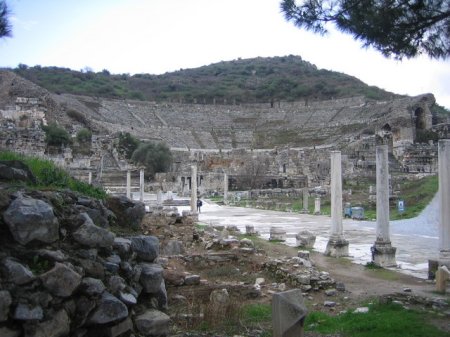
Great Theater
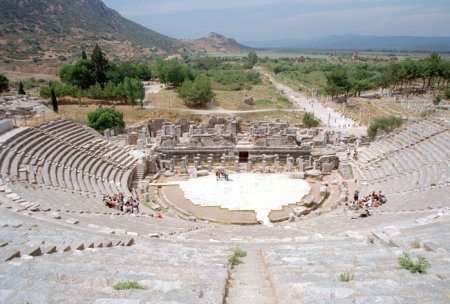
Great Theater
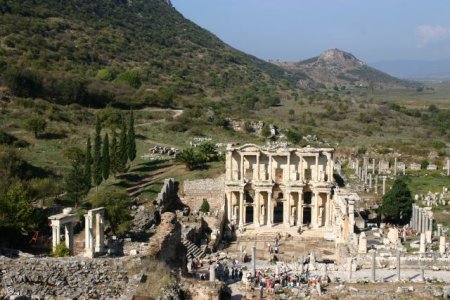
Library of Celsus

Temple of Hadrian
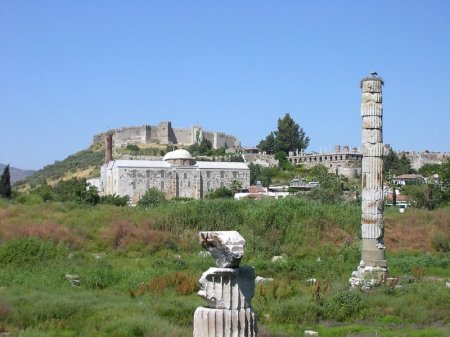
Temple of Artemis
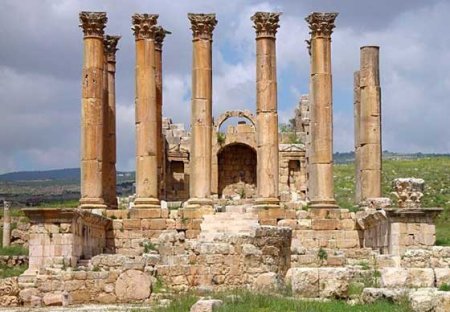
Temple of
Artemis
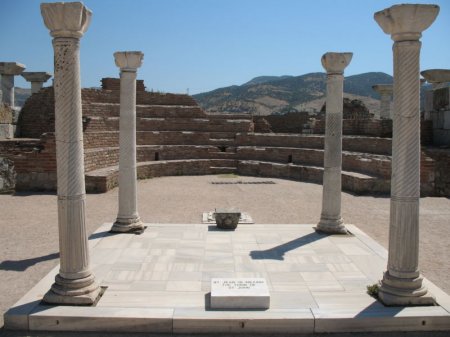
Tomb of
Saint John |
|

Kusadasi |
|
|
Crete |
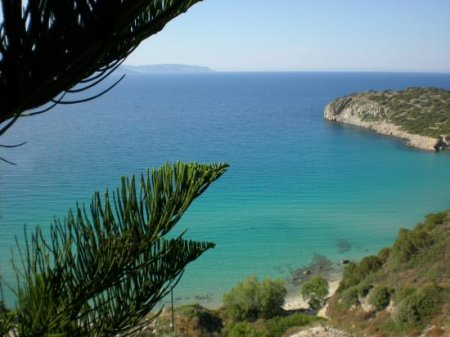
Coast of Crete |
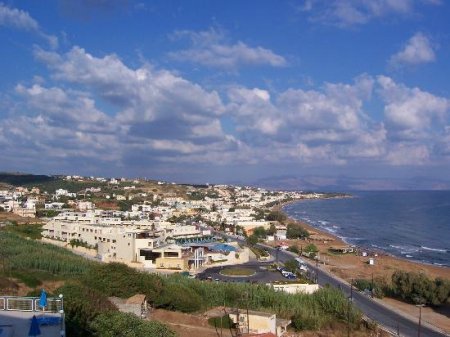
Heraklion, Crete |
|
Island of Crete |
Day Six |
We arrive in Iraklion, the capital
city of Crete at 7:00 AM on
Friday.
Iraklion
rests on the side of a hill overlooking the Cretan Sea.
The city is named after Hercules (Herakles, or in Modern
Greek, Iraklís). Though a bustling metropolis, Iráklion
is also the gateway to the nearby stunning ancient ruins
of advanced civilizations.
History is very much
alive in Iraklion just like in most Greek cities. The
central square while surrounded by cafes, stores and
restaurants, is dominated by the fountain of the Lions,
built by Morozini the venetian governor in 1628. The
Town Hall, is today housed in the Venetian Loggia, a
building from the same era. At the end of the central
market is a coffee house, housed at the "Koubes" a
fountain built by the Turks when they converted the
nearby church of the Saviour to the Valide mosque. All
around the old part of the city ,a visitor can walk
following the old Venetian walls that meet at a bastion,
called "Koules", that dominates the old harbour of the
city .
Throughout history, the island of Crete has been a
meeting point for different civilizations. It is the
fifth largest island in the Mediterranean and the
southernmost island of Greece. A few miles south of the
city of Iraklion are the famous archaeological ruins of
Knossos and the Palace Complex of King Minos.
Knossos Palace is one of the most spectacular of Crete's
Minoan sites. The Minoan civilization flourished in
Crete during the Bronze Age, around 3000 to 1100 BC. The
palace has been linked to the mythological King Minos,
the labyrinth and the Minotaur, and the story of
Daedalus and Icarus. Excavations have further revealed
the astounding palace, villas, roads, columns,
courtyards, temples and theater. The ruins were
discovered in 1878 and Sir Arthur Evans unearthed the
palace in 1900. Knossos was the capital of the Minoan
Kingdom, having its religious and administrative center
in the three-story frescoed palace. Built in about 1700
BC on the rubble of an older structure, it was destroyed
around 1450 BC, possibly by the earthquakes and tidal
waves caused by a volcanic eruption in Santorini. The
buildings cover an area of 2 hectares and include the
Small Palace, Royal Villa, Caravanserail and the House
of Frescoes.
Try a venture to the Lassithi Plateau. On the way, you
will enjoy spectacular mountain vistas and wide-open
countryside on your way. Surrounded by a natural barrier
of mountains and some 850 meters above sea level, this
fertile plain is where 10,000 wind pumps used to draw up
the subterranean water for irrigation. Many are still in
use today. The Lassithi plateau is a large fertile
plain in the NW part of Eastern Crete. People have lived
here since Neolithic times (6000 B.C.) Soil fertility
of the plateau is due to alluvial run-off, from times
immemorial, when melting snow comes down from the
surrounding mountains in spring. he Venetian rulers
installed vast and ingenious irrigation works during the
15th century. White-sailed windmills, some
10.000 in all, irrigated the plain. Unfortunately (for
travelers), in the last decennia of the 20th century,
most if not all working windmills have been abandoned
for the more efficient diesel and electrical pumps, the
few remaining ones being relegated to signposting the
many tavernas which line the main road that rings the
plateau.
Visit the
Monastery of Kera, where you will see the impressive
14th century icons, including the miraculous icon of the
Virgin Mary. Stop at the Seli Gate - an ideal spot to
admire the rough landscape of the Lassithi plateau and
treat yourself to "meze" (Greek snack) at the Seli
restaurant. The "meze" includes a glass of local ouzo or
wine, cheese, hard bread, tomato and olives. As you
descend down the mountain pass toward the north coast of
Crete, you will be treated with superb views over
gorges, valleys and quaint villages.
If
you prefer to spend the day relaxing, why not bask on
one of the glorious north coast beaches, socialize and
people-watch in the cafés and restaurants of Platía
Venizélou.
|

Heraklion, Crete
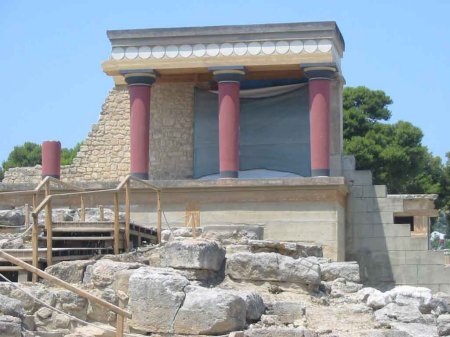
Knossos Palace
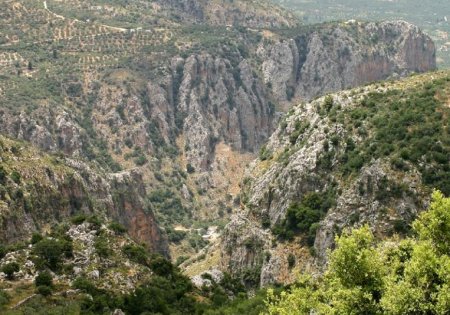
Lassithi Plateau
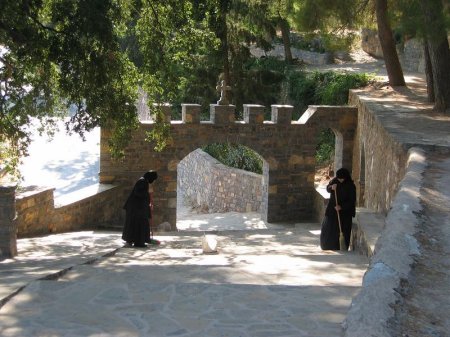
Monastery
of Kera |
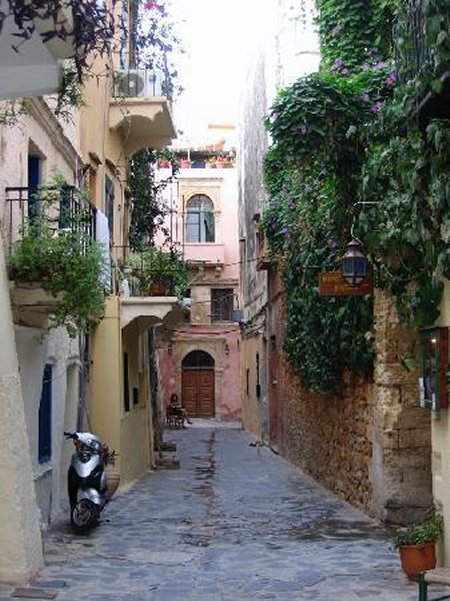
Heraklion Street Scene |
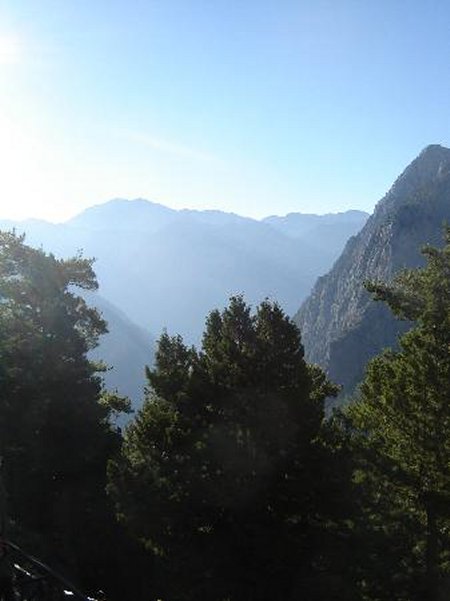
Samria Gorge |
|
|
About the Trip
Greece and Italy
|
|
|
|
|
A
visit to the Mediterranean is on
every person's must-see short list. The
Mediterranean is one of the world's favorite
vacation destinations
The Greek Trip will be the 13th SSQQ Cruise Trip.
As always, you have the best of both worlds.
You can be alone with your sweetheart perched on a
terrace overlooking the sea in Sicily or you can hang with the group whenever you
wish. Wherever you go, you will always have
friends. We watch out for each other. At
dinner time when you wish to share tales of your
adventures, you won't be talking to strangers, you
will be talking with friends from home.
We chose this time for two reasons. We were
able to get a great rate for this prime sailing time
and vacationing in July will make it easier for
those in the field of education to join us.
Our trip will be aboard Royal Caribbean’s
Navigator of the Seas.
This ship is part of Royal Caribbean's Voyager
Class,
among the biggest vessels
in the world. It is 138,000
tons of fun.
A beautiful wooden dance floor is
featured in a spacious attractive non-smoking
lounge. The ship is so plush even the Disco has a
wooden floor as well. The
Navigator of the Seas sports some of the industry's
most amazing features: a rock-climbing wall,
ice-skating rink, an indoor, mall-like promenade,
basketball court and in-line skating track.
The ship is relatively new;
it entered service during the spring of 2003.
|
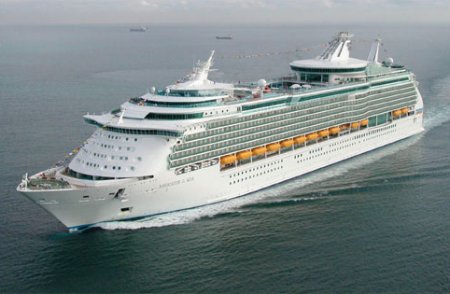
RCCL Navigator of
the Seas
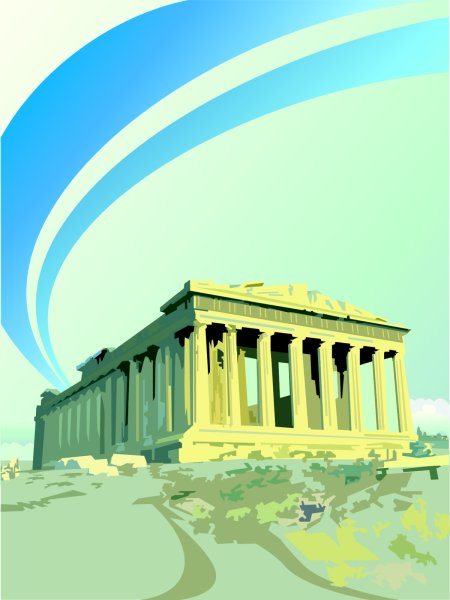
The Acropolis in
Athens |
|
|
|
|